One of the first steps when creating a new wireless instrumentation network using ISA100 Wireless, or any other industrial wireless network, is a site survey. This step is not part of any wireless standard, nor is it likely part of any network management platform, so it requires some creativity. Radio propagation patterns can be difficult to predict, but following a few basic design guidelines ensures a much higher level of success.
Some wireless consultants make the process very complex using simulations and reading test signals, but these often do not ultimately match the real world. Other approaches are simpler and involve taking a few distance measurements and establishing sight lines, which often works just as well. For this article, we will concentrate more on the latter, simpler approach.
ANSI/ISA-100.11a-2011 (IEC 62734), Wireless Systems for Industrial Automation: Process Control and Related Applications, networks are designed to support wireless field instrumentation. This protocol specification is part of the larger ISA100 Wireless series. Although network management platforms have an extraordinary capability for self-organization, this feature cannot overcome unreliable radio links.
But, the network management platform can use its diagnostic capabilities to measure the health of the communication and the devices. It can identify unreliable links so they can be fixed, and with improved communication, the network manager can reestablish a reliable link.
How signals propagate
Although it is not a perfect model, thinking of radio in the same way as visible light is accurate much of the time. Wireless networks depend largely on line of sight (LOS). If a wireless flowmeter is trying to transmit to a gateway in its LOS, the likelihood of a good link is very high. More potential obstructions are transparent to radio frequencies than visible light, but this is affected by frequency. A leafy tree is transparent to signals at 90 MHz, but 2.4-GHz signals will suffer some attenuation.
Metallic objects are the great enemy of radio propagation, but can also help under the right conditions, which is why refineries and chemical plants provide many challenges for wireless networks. In one case, a steel-shell storage tank can be helpful by reflecting a signal, while other times it is as an obstacle. Like visible light, much depends on the surface angles.
General wireless principles say to avoid metallic surfaces when placing antennas for field devices, such as process instruments and actuators, routers, and gateways. The best situation is to mount the antenna vertically so that it is unobstructed on all sides (figure 1). If a gateway is mounted next to a metallic pole, the signal will be attenuated, even on the side away from the pole. It is far better to move the antenna to the top of the pole, so it can extend into free space, or to extend the antenna mounting horizontally, so there is at least a 1-meter gap between the antenna and the pole.
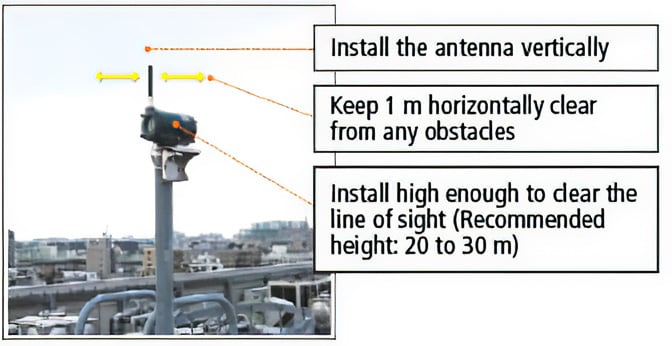 Figure 1. For the best signal propagation, each antenna should be mounted vertically with at least 1 m of clear space around it horizontally. This normally means mounting the antenna as high on a structure as possible.
Figure 1. For the best signal propagation, each antenna should be mounted vertically with at least 1 m of clear space around it horizontally. This normally means mounting the antenna as high on a structure as possible.
Understanding the Fresnel zone
Elevated antenna placement is important, because radio communication does not move in a tight beam like a laser. To send the signal from one point to another efficiently, some area in the shape of an ellipse is required. This area is called the Fresnel zone (figure 2). The amount of room available for the signal to spread has a huge effect on signal strength and the distance it can carry, since the longer the distance, the fatter the zone needs to be in the center. Anything violating the zone, which could even be the ground itself, attenuates the strength. Therefore, trying to squeeze a signal through a narrow space, even though it may allow direct LOS, can result in signal attenuation.
For example, where the LOS side clearance has an open space with a radius of 4 m, the communication range can be 500 m. However, when trying to send the signal through a more constricted area where the open space radius is only 2 m, the effective distance will be cut by 75 percent to 128 m. Having open, unobstructed space makes a huge difference, but this is typically a problem in most congested plant environments. This is why mounting devices and antennas as high as possible is so important.
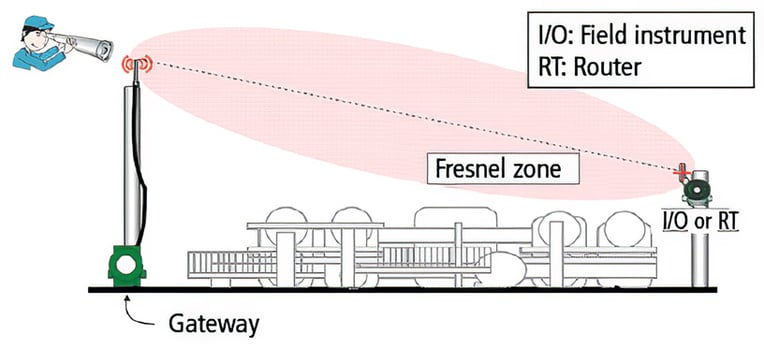 Figure 2. Radio waves tend to propagate through an elliptical space formed between the two antennas. The longer the distance, the larger the required diameter at the center. This space should be as unobstructed as possible to avoid signal attenuation.
Figure 2. Radio waves tend to propagate through an elliptical space formed between the two antennas. The longer the distance, the larger the required diameter at the center. This space should be as unobstructed as possible to avoid signal attenuation.
Meshing vs. routing devices
ISA-100.11a has mechanisms for device-to-device meshing, but the more desired network topology is one where a field device can communicate directly with the gateway, or directly to a router connected to the gateway (figure 3). The goal is to avoid the need for meshing device-to-device, because sending signals between multiple field devices slows down data movement and taxes the devices' batteries.
To facilitate these transmissions, gateways and routers should be mounted as high as practical to clear any surrounding equipment and permit clear LOS connections. My company calls this practice of having a mesh of routers communicating above the plant equipment a sky mesh, and it takes advantage of more powerful transmitters than are practical for individual wireless field devices.
Placement of individual field devices is not as simple. Most native wireless devices, such as a differential pressure instrument, have an integral wireless transmitter and antenna (figure 4). This is very convenient, but can complicate signal propagation. Placement in the process piping or vessel often dictates where the device must be mounted, the antenna orientation, and the surrounding obstructions. Using an antenna extension can address these issues. Another alternative is to add a router mounted as near to the instrument as possible and clear of obstructions. If more than one instrument is in the same difficult location, a single router can service a group.
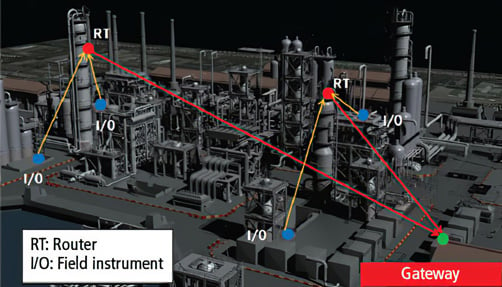 Figure 3. The gateway is the end point of the network, and is connected to the control and monitoring system via hard wiring. Routers serve as relay points, gathering information from the field devices and passing it to the gateway.
Figure 3. The gateway is the end point of the network, and is connected to the control and monitoring system via hard wiring. Routers serve as relay points, gathering information from the field devices and passing it to the gateway.
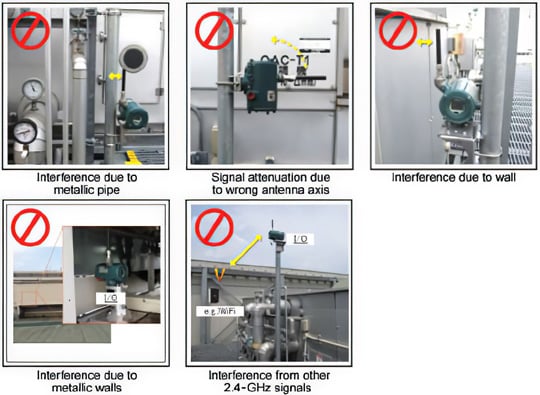 Figure 4. Having an antenna mounted on the field device is common, but placement of the field device may put it in a location prone to interference. An external add-on antenna may be needed to improve communication.
Figure 4. Having an antenna mounted on the field device is common, but placement of the field device may put it in a location prone to interference. An external add-on antenna may be needed to improve communication.
Laying out a network
Most networks are designed from two ends, the field and the control room. Field devices must be located according to their process function, which could easily be in a congested pipe jungle where equipment interferes with clear signal propagation. The final gateway is often placed near the control room, because it is hardwired to the control system. The network must bridge this gap.
Creating a sky mesh requires finding where it is practical to place routers. Ideally, these should be high off the ground and as close to the individual field devices as possible. Ensuring reliable communication between the field devices and the nearest sky mesh router may involve a secondary router in between to compensate for signal loss.
In most process plants, it is not difficult to find tall structures, such as distillation columns, but they may not be located where they are useful for router placement. Positioning antenna to avoid signal blockage problems associated with such large metallic structures can be tricky. As a rule of thumb, if the router is placed 30 m above the ground, it can reach individual field devices close to ground level up to 50 m away (figure 5). This assumes a few beneficial reflections, balanced against some obstructions from piping.
The connection from each field device to the closest router is the most challenging because it often has the most obstructions. Communication between routers and the gateway is easier to visualize and evaluate, since those components are mounted higher above the process equipment in more open space.
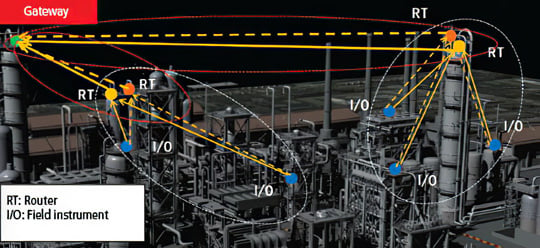 Figure 5. Routers in high positions can reach down to communicate with field devices closer to ground level. The practical area of coverage under favorable conditions is roughly a 90º to 100º cone, with the router as the cone’s apex.
Figure 5. Routers in high positions can reach down to communicate with field devices closer to ground level. The practical area of coverage under favorable conditions is roughly a 90º to 100º cone, with the router as the cone’s apex.
Evaluating performance
The two most common measures of network performance are bit error rate (BER) and packet error rate (PER). The former uses predetermined bit patterns to check which are received incorrectly, a process requiring dedicated software on all the field devices, routers, and gateways. It must be performed as a specific test, sending the designated patterns.
PER performance measurements, on the other hand, deal with complete packets and can be done without special tools during normal communication. If a problem is developing, there will be a detectable change in the PER.
The most important indicator is determining how often packets get through correctly the first time. Getting the PER as low as possible is the objective, but this can only be done when all radio links are working reliably.
A well-designed ISA-100.11a wireless instrumentation network can operate as dependably as wired I/O in most applications. When the communication links connect reliably, latency will be minimized, allowing control room operators and other plant personnel to have all the information they need in a timely manner.
A version of this article also was published at InTech magazine.




